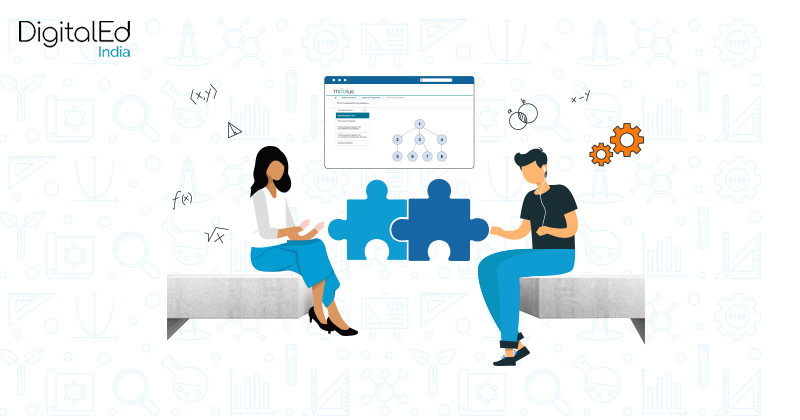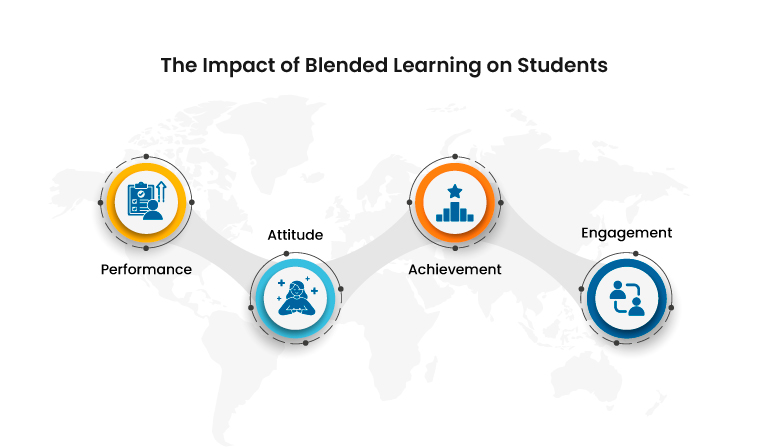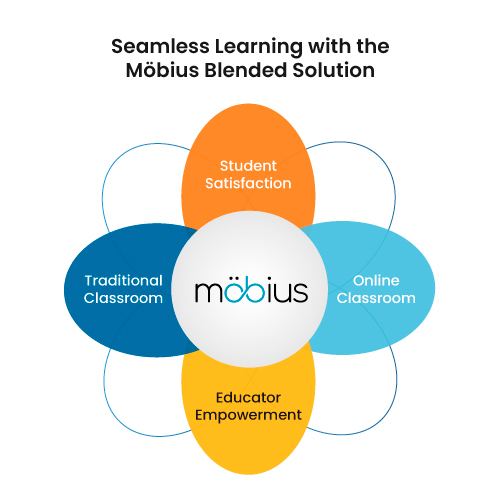Bridging the Gap: Möbius Classroom Redefines Blended Learning

In today’s dynamic Indian education landscape, technology integration is crucial, especially in STEM. Traditional teaching methods often face challenges such as large class sizes, rote memorization, and passive learning. Hence, innovative solutions like blended learning are needed to bridge the gap between classroom and online learning.
This blog explores innovative pedagogies, traditional STEM education obstacles, and how Möbius STEM Learning transforms education for learners, educators and institutions.
Without further ado, let’s get into the significance of blended learning.
Enhancing STEM Education: The Vital Role of Blended Learning
In the realm of STEM education, fostering engagement and deep understanding is paramount. Blended learning, the strategic combination of traditional classroom teaching with online resources and interactive STEM learning activities, has emerged as a game-changer in this regard. Its seamless integration of technology in STEM education offers students a dynamic and personalized learning experience, ultimately enhancing their grasp of complex STEM concepts.
Let’s look at some eye-opening numbers:
- 73% of educators acknowledge that blended learning enhances student engagement.
- 60% of instructors observe an enhancement in academic ability with blended learning.
- 59% of students exhibit higher motivation with the adoption of blended learning approaches.
- 82% of students express a preference for blended teaching over traditional classroom settings.
- 85% of educators attribute their shift towards blended classrooms to the improvement of personalized learning experiences.
Now let’s delve into why this innovative pedagogy is increasingly recognized as a cornerstone of effective STEM education.
- Personalized Learning in STEM: Accommodate diverse learning styles and paces with blended pedagogies, allowing students to progress through material at their own speed.
- Maximized Accessibility: Whether it’s immersive simulations, educational videos, or interactive STEM learning activities, these digital tools break down geographical barriers and provide equitable opportunities for all learners.
- Promotion of Critical Thinking: Online discussions, collaborative projects, and problem-solving tasks challenge students to think critically and apply theoretical knowledge to real-world scenarios.
- Flexibility and Adaptability: Blended learning equips students with the digital literacy and flexibility necessary to navigate a constantly changing digital world.
- Data-Driven Insights: Analyzing data on student performance enables educators to tailor instruction, identify areas for improvement, and provide targeted support.
By harnessing the synergies between traditional teaching methods and an e-learning platform, educators can cultivate a rich and engaging learning environment that nurtures curiosity, creativity, and critical thinking in the next generation of STEM leaders.
Blended Learning: A Boon for Student Performance, Attitude, Achievement & Engagement

Performance
Performance in blended learning refers to the measurable achievements of students across both online and offline educational settings. It encompasses various aspects such as student assessment, evaluation, and analysis.
Numerous studies have highlighted its positive impact on performance. For instance, compared to traditional learning approaches, blended learning has been found to enhance critical thinking skills, knowledge delivery, disposition improvement, and language proficiency among learners. Furthermore, it optimizes learning flexibility and results in substantial improvement in soft skills, including communication, problem-solving, and reasoning.
Attitude
Attitude toward blended learning within STEM education refers to an individual’s perspective on the integration of online and traditional face-to-face teaching methods. This encompasses aspects such as self-assessment of comprehension, satisfaction with the learning experience, proficiency in communication, and overall confidence in STEM subjects.
Research indicates a generally positive reception of blended learning effectiveness within STEM fields. For instance, it has been observed to enhance students’ grasp of complex STEM concepts and improve problem-solving skills. This innovative learning method is also credited with fostering a more interactive and engaging learning environment, leading to increased student participation and enthusiasm for STEM subjects. Furthermore, incorporating e-learning platforms into STEM instruction has shown promise in enhancing students’ technological literacy and adaptability, essential skills for success in today’s digitally driven world.
Achievement
Achievement in blended learning refers to students’ level of success or accomplishment attained through participating in a combination of online and traditional face-to-face learning activities. This encompasses various learning outcomes such as enhanced academic performance, increased engagement, and improved critical thinking and problem-solving skills. Assessment of achievement in involves various methods including graded quizzes, assignments, class participation, peer evaluations, and self-reflection.
Additionally, leveraging learning analytics and data-driven assessment in STEM education can offer valuable insights into students’ progress. This aids instructors in tailoring teaching strategies effectively. Achievement is influenced by effective blended instructional design, quality learning materials, and ongoing student support.
Engagement
Engagement in blended learning refers to the extent to which students actively participate and invest themselves in the learning process, whether it’s online or in-person. This involvement includes participating in discussions, completing assignments, and seeking additional learning opportunities beyond the curriculum.
In blended learning, engagement can be cultivated through different strategies like fostering collaboration among students, providing feedback on their work, and utilizing interactive STEM learning activities and multimedia resources to enrich the learning experience. Assessment in STEM education such as tools for self-evaluation, course evaluations, and participation quizzes help gauge engagement levels. Ultimately, fostering engagement is essential for boosting student motivation, enhancing learning outcomes, and establishing a supportive academic environment conducive to success.
Möbius STEM Learning: Transformative Blended Solution

Möbius STEM Learning is at the forefront of educational innovation, offering a dynamic bridge between digital and traditional learning methods. Through its cutting-edge features and intuitive interface, Möbius provides educators with a comprehensive toolkit to seamlessly integrate online and offline learning experiences.
- Möbius seamlessly blends digital and traditional learning methods with an e-learning platform catered specifically for complex STEM concepts.
- Customizable content, custom-access criteria and in-depth analytics enable personalized learning in STEM tailored to individual student needs.
- Möbius STEM learning facilitates collaboration and knowledge sharing among educators and students, encouraging research and igniting curiosity.
- Möbius STEM Learning utilizes Algorithmically Randomized Questions, a dynamic self-evaluation tool programmed to grasp complex STEM nomenclature.
- Educators can integrate assessment within lessons using the In-Line Questions feature, eliminating the illusion of knowing and tracking student progress.
- Möbius STEM learning cultivates essential skills like collaboration, critical thinking, and digital literacy, preparing students for future careers.
In conclusion, Möbius STEM Learning stands as a transformative solution at the intersection of traditional methods and an e-learning platform. Möbius enables educators to blend online resources with face-to-face teaching, creating personalized learning experiences for students. Its intuitive interface and innovative features foster collaboration, enhance engagement and promote critical thinking skills essential for success in STEM and beyond. The benefits of Möbius STEM education pave the way for a more dynamic and effective educational landscape.
Want to explore the Möbius experience? Book a personalized demo today!